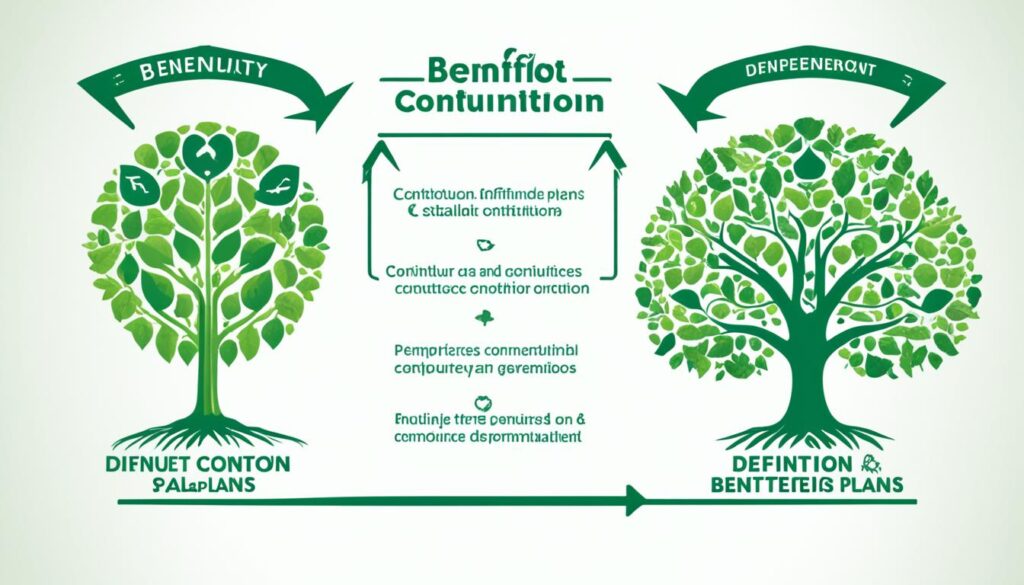As the landscape of retirement planning continues to evolve, Employer-Sponsored Retirement Plans stand out as a pinnacle of employee benefits in the USA. These plans are crucial components in the financial wellness toolkit for American workers, providing a systematic approach to retirement savings. Delving into the multifaceted world of retirement savings plans, employees benefit from the compound growth on their savings along with significant tax benefits, while employers gain competitive advantage by offering these sought-after benefits.
Key Takeaways
- Employer-Sponsored Retirement Plans enhance retirement planning through tax benefits and savings growth.
- These plans are an integral part of employee benefits, helping attract and retain skilled workers.
- Employer contributions to retirement savings plans aid in boosting employee morale and financial security.
- Retirement Plans such as 401(k)s and HSAs offer both pre-tax and tax-advantaged contributions.
- Strategic planning with these employer-sponsored options can lead to substantial retirement savings.
- Understanding the intricate tax implications and benefits is essential for maximizing retirement savings.
Introduction to Employer-Sponsored Retirement Plans
Organizations today are increasingly recognizing the importance of providing their employees with comprehensive retirement investment options. As these benefits become a cornerstone for financial security in later life, employer-sponsored plans emerge as a critical element in this offering. Not only do such plans facilitate retirement savings, they also incorporate healthcare savings plans, making them indispensable for employees.
What Are Employer-Sponsored Retirement Plans?
Employer-sponsored retirement plans are structured programs designed to deliver tax-advantaged employee benefits. They play a vital role in helping employees prepare for retirement by offering convenient pension plans and other savings vehicles. Companies often extend these plans as part of a broader employee benefits package, which might include various healthcare and retirement savings programs.
The Dual Benefit: Employee Savings and Employer Tax Breaks
The allure of employer-sponsored retirement plans lies in their dual benefit structure. For employees, these plans represent a pathway towards fiscal responsibility and retirement readiness. For the employer, offering such plans often translates into substantial tax breaks. The motivation to provide these benefits is further reinforced when companies opt to match employee contributions, thus greatly enhancing the value of these plans.
Types of Services Covered by Employer-Sponsored Plans
Employer-sponsored plans are far-reaching in terms of the services they cover. These plans are not a monolith; they cater to various needs and preferences, ranging from traditional retirement savings accounts to more specific healthcare savings plans. Below, we explore the different facets of these plans:
- Retirement Savings Plans: These are typically the 401(k) plans, traditional IRAs, or Roth IRAs, where employees can allocate a portion of their income, often before taxes, to be invested for their retirement.
- Healthcare Benefits: Medical, dental, and vision plans, along with Health Savings Accounts (HSAs), offering dedicated funds for healthcare expenses, constitute another crucial component.
Through diverse arrangements catering to both immediate and future financial stability, employer-sponsored retirement plans stand out as a multifaceted tool in the arsenal of employee benefits.
The Advantages of Tax-Deferred Retirement Savings Plans
For many Americans, retirement planning is a critical aspect of their long-term financial stability. Recognizing the importance of preparing for the future, our focus turns to the key benefits of tax-deferred savings vehicles that are central to optimizing retirement income. Tailored to meet the needs of retirement plan participants, these plans include popular options such as the 401(k) and Roth 401(k), each offering unique tax advantages designed to bolster your nest egg.

Understanding 401(k) and Roth 401(k) Tax Benefits
The traditional 401(k) plan stands out as a beacon of tax efficiency for employees seeking to enhance their retirement plan outcomes. By contributing pre-tax dollars, you reduce your current taxable income, thereby lowering the amount of tax you pay today. Meanwhile, your savings enjoy the potential of tax-deferred growth, meaning earnings on investments within your 401(k) are not taxed until you decide to make withdrawals, typically during retirement when many find themselves in a lower tax bracket.
In sharp contrast are the Roth 401(k) plans, where contributions are made with after-tax dollars. The magic of the Roth 401(k) unfolds when you retire: the withdrawals, which include the earnings on your investments, are entirely tax-free, provided certain conditions are met. This can be especially advantageous if tax rates are higher when you retire or if your retirement income puts you in a higher tax bracket.
Exploring Pre-Tax Contributions and Their Impact
By utilizing pre-tax contributions in a traditional 401(k) plan, you’re engaging in a strategic financial move that benefits both your present and future self. The impact is twofold: you enjoy immediate tax relief, and your investments compound over time without the headwind of annual tax deductions—effectively a win-win scenario for retirement plan participants intent on securing a comfortable retirement.
While the lure of immediate tax benefits is compelling with traditional 401(k) plans, it is essential to compare the benefits with those of the Roth 401(k). The choice between these two hinges on your current tax situation and the anticipation of your financial state at retirement—the pivotal decision in the ongoing quest towards maximizing your retirement resources.
Defined Benefit vs. Defined Contribution Plans
When planning for retirement, understanding the difference between defined benefit plans and defined contribution plans is crucial for a secure financial future. These employer-sponsored pension plans offer varying degrees of employer involvement and participant risk, shaping the retirement landscape for American workers.
The Traditional Pension Plan Model
Defined benefit plans, also known as traditional pension plans, are characterized by a guaranteed payout upon retirement. The monthly benefit typically correlates with the employee’s earnings history, tenure, and age. The main attraction of these plans is the predictability and security they offer, since the employer bears the investment risk.
Employee-Controlled Investment in Defined Contribution Plans
In contrast, defined contribution plans, such as 401(k) plans, entrust the investment control to the employees. Funds accumulated through these plans depend upon the contributions and the success of chosen investments, making the future benefits less predictable. This format reflects a shift in the retirement plan paradigm, with the employee now assuming the investment risk.

| Plan Type | Pay-Out Format | Investment Risk | Employer Contribution | Employee Contribution |
|---|---|---|---|---|
| Defined Benefit Plan | Fixed Monthly Benefit | Employer | Typically Sole Contributor | None or Minimal |
| Defined Contribution Plan | Dependent on Account Value | Employee | Optional, often matches employee contributions | Primary Source of Funding |
The choice between a defined benefit plan and a defined contribution plan affects not only the retirement outcomes but also the approach to retirement planning and risk management. Each option offers distinctive features, which employers and employees must weigh carefully in view of their unique financial goals and circumstances.
Unique Retirement Plans: SEPs, ESOPs, and Profit Sharing
In the landscape of retirement planning, there exists a suite of plans tailored to meet various business needs while providing employees with opportunities to build their retirement savings. Beyond the standard 401(k) options, Simplified Employee Pension Plans (SEPs), Employee Stock Ownership Plans (ESOPs), and profit sharing plans offer distinctive advantages and serve the dual purpose of supporting employees’ future financial security and fostering a culture of investment in a company’s success. These plans, supervised by skilled retirement plan administrators, are crucial components in a well-rounded benefits package.
Simplified Employee Pension Plans and Their Ease
The Simplified Employee Pension Plan, or SEP, stands out as a compelling choice for small business owners and self-employed individuals due to its simplicity and ease of management. With a SEP, an employer can make contributions to traditional IRAs (SEP-IRAs) set up for each eligible employee, including themselves. The tax-favored status of contributions and minimal reporting requirements make SEPs a straightforward solution for retirement savings.
Employee Stock Ownership Plans as a Retirement Strategy
Employee Stock Ownership Plans, known as ESOPs, represent a unique confluence of retirement planning and employee engagement. By investing primarily in the employer’s stock, ESOPs align the workforce’s retirement benefits with the company’s overall performance. The success of an ESOP can effectively transform employees into partner-stakeholders, creating a vested interest in the company’s prosperity while adding a valuable dimension to their retirement portfolio.
Profit Sharing and Its Influence on Employee Retirement
Profit sharing plans introduce a performance-driven approach to retirement benefits, where a portion of the company’s profits is shared with employees. Often tied to a 401(k) plan, profit sharing can significantly enhance an employee’s retirement savings, establishing a direct correlation between the company’s financial success and the individual’s financial well-being. The incentive provided by profit sharing plans often leads to increased employee motivation and retention, as they stand to directly benefit from the company’s achievements.
Unique Retirement Plans: SEPs, ESOPs, and Profit Sharing
What Are Employer-Sponsored Retirement Plans?
Employer-Sponsored Retirement Plans are retirement savings plans provided by employers to offer tax-advantaged employee benefits. These plans allow employees to save for retirement, often with the benefit of employer contributions, and can include healthcare savings plans, insurance plans, and more.
The Dual Benefit: Employee Savings and Employer Tax Breaks
These plans offer a dual benefit; they help employees save for retirement through tax-advantaged savings vehicles, while employers receive tax breaks for providing the plans. Employers may also use these plans as tools to attract and retain top talent.
Types of Services Covered by Employer-Sponsored Plans
Services covered by Employer-Sponsored Retirement Plans can include a range of retirement investment options and pension plans, in addition to healthcare benefits through vehicles like Health Savings Accounts (HSAs).
Understanding 401(k) and Roth 401(k) Tax Benefits
A traditional 401(k) plan allows for pre-tax contributions which can reduce taxable income and enable tax-deferred growth. Upon withdrawal during retirement, the savings are taxed, often at a lower rate. A Roth 401(k) plan allows for after-tax contributions with the advantage of tax-free withdrawals during retirement, given that certain conditions are met.
Exploring Pre-Tax Contributions and Their Impact
Pre-tax contributions to retirement plans like the traditional 401(k) reduce an individual’s taxable income in the year the contributions are made. This not only lowers the current tax burden but also allows for tax-deferred growth of investments, potentially leading to more significant savings over time.
The Traditional Pension Plan Model
Traditional pension plans, also known as defined benefit plans, promise a specified monthly benefit upon retirement based on factors such as salary history and length of employment. These benefits are often backed by federal insurance and are funded and managed by the employer.
Employee-Controlled Investment in Defined Contribution Plans
Defined contribution plans, such as 401(k) plans, place the investment decisions primarily in the hands of the employee. The retirement benefit amount depends on the contributions made and the performance of the chosen investments. The employee bears the risk and rewards of investment options within the plan.
Simplified Employee Pension Plans and Their Ease
Simplified Employee Pension Plans (SEPs) offer an easy way for employers to contribute to retirement savings plans. Contributions are made to an individual retirement account (IRA) on behalf of the employee, providing tax-favored benefits with minimal paperwork and reporting requirements.
Employee Stock Ownership Plans as a Retirement Strategy
Employee Stock Ownership Plans (ESOPs) are retirement plans designed to invest primarily in the stock of the sponsoring employer. This aligns the employees’ retirement savings with the performance of the company, potentially leading to increased employee investment in the success of the company.
Profit Sharing and Its Influence on Employee Retirement
Profit-sharing plans allow employers to make discretionary contributions to their employees’ retirement savings based on the company’s profits. These may be offered as standalone plans or in conjunction with other retirement plans like a 401(k), tying the retirement benefits of employees to the financial health and success of the business.
How Can Employer-Sponsored Retirement Plans Maximize Flexibility for Retirement Saving?
Employer-sponsored retirement plans offer flexibility in retirement saving. These plans allow employees to contribute to their retirement saving plans flexibility through payroll deductions. Employers may also match contributions, providing an added incentive for employees to save. The flexibility to choose investment options further maximizes savings potential for retirement.

